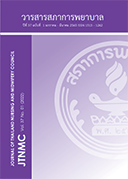Non-Suicidal Self-Harm Behaviour and Risk Factors amongst Undergraduate Nursing Students
Keywords:
non-suicidal self-harm behaviour, risk factors, nursing studentsAbstract
Objective: To study the percentage and risk factors of non-suicidal self-harm behaviour amongst undergraduate nursing students in the school year 2020, during the two-week period leading to the time of the research
Design: Cross-sectional descriptive study
Methodology: A total of 133 undergraduate nursing students were included in this study using convenience sampling. Research instruments consisted of 1) Patient Health Questionnaire-9 (Thai version); 2) Self-Harm inventory (Thai-version); and 3) Stressful Life Event questionnaire. The data were analysed using descriptive statistics and multiple regression analysis with the Enter Method.
Results: During the two-week period leading to the time of the research, non-suicidal self-harm behaviour was found in 36.1% of the subjects. The most frequent type of non-suicidal self-harm behaviour was the act of intentionally putting oneself in a rejected relationship. The factors found to be in a statistically signifcant relationship with non-suicidal self-harm behaviour amongst the subjects were: 1) a history of alcohol consumption; 2) rebukes or insults by parents; 3) anxiety about the practicum; 4) loss of beloved persons, pets, or objects; and 5) a state of depressive disorder. Of these, a state of depressive disorder was the major risk factor accounting for the non-suicidal self-harm behaviour amongst the subjects during the two weeks up to the time of the research (OR = 2.57, 95% CI = 1.05-6.29).
Recommendations: Monitoring and screening for non-suicidal self-harm behaviour are highly necessary, especially amongst students with symptoms of depressive disorder. Also important are the building of an awareness of such behaviour and the screening of other factors that could affect students who have sexual-partner-changing behaviour or a tendency for intentionally making themselves rejected by their partners.
Downloads
References
Lim K-S, Wong CH, McIntyre RS, Wang J, Zhang Z, Tran BX, et al. Global lifetime and 12-month prevalence of suicidal behavior, deliberate self-harm and non-suicidal self-injury in children and adolescents between 1989 and 2018: a meta-analysis. Int J Environ Res
Pu. 2019 Nov 19;16(22):4581.
Cipriano A, Cella S, Cotrufo P. Nonsuicidal Self-injury: a systematic review. Front psychol [Internet]. 2017 [cited 2020 Jan 28]. Available from: https://www.frontiersin.org/articles/10.3389/fpsyg.2017.01946/full?report=reader
Gholamrezaei M, De Stefano J, Heath NL. Nonsuicidal self-injury across cultures and ethnic and racial minorities: a review. Int J Psycho. 2017;52(4):316–26.
Huang Y-H, Liu H-C, Sun F-J, Tsai F-J, Huang K-Y, Chen T-C, et al. Relationship between predictors of incident deliberate self-harm and suicide attempts among adolescents. J Adolescent Health. 2017 May 1;60(5):612–8.
Wu D, Rockett RHI, Yang T, Feng X, Jiang S, Yu L. Deliberate self-harm among Chinese medical students: a population-based study. J Affect Disorders. 2016; 202: 137–44.
Aggarwal S, Patton G, Reavley N, Sreenivasan SA, Berk M. Youth self-harm in low- and middle-income countries: systematic review of the risk and protective factors. IntT J Soc Psychiatr. 2017;63(4):359–75.
Bennardi M, McMahon E, Corcoran P, Griffn E, Arensman E. Risk of repeated self-harm and associated factors in children, adolescents and young adults. BMC Psychiatry. 2016 Nov 24;16(1):421.
Walt V der F. Self-harming behaviour among university students: a south african case study. J Psychol Afr.2016; 26(6):508–12.
Raza A, Abbasi NUH, Khurshid M, Ansari MI. The relationship between depression, anxiety, stress and self-harm among college students: A cross-sectional survey. Pak Armed Forces Med J. 2017;68(1):137–42.
Yang F-Y, Lai CY, Yen C-F, Hsu Y-Y, Zauszniewski JA. The depressive symptoms, resourcefulness, and self-harm behaviors of adolescents. J Nurs Res. 2017 Feb;25(1):41–9.
Kumar A, Srivastava M, Srivastava M. A situational analysis of tendency of deliberate self-harm among students. IJPSM. 2017;48(1–2):90-97.
Borschmann R, Becker D, Coffey C, Spry E, Moreno-Betancur M, Moran P, et al. 20-year outcomes in adolescents who self-harm: a population-based cohort study. Lancet Child Adolesc Health. 2017 Nov;1(3):195–202.
Guerreiro DF, Sampaio D, Figueira ML, Madge N. Self-harm in adolescents: a self-report survey in schools from Lisbon, Portugal. Arch Suicide Res. 2017;21(1):83–99.
Vergara GA, Stewart JG, Cosby EA, Lincoln SH, Auerbach RP. Non-suicidal self-injury and suicide in depressed adolescents: Impact of peer victimization and bullying. J Affect Disorders. 2019; 245: 744–9.
Tang J, Yang W, Ahmed NI, Ma Y, Liu H-Y, Wang J-J, et al. Stressful life events as a predictor for nonsuicidal self-injury in southern chinese cdolescence: a cross-sectional study. Medicine (Baltimore). 2016; 95(9): e2637
Chaniang S, Meuangkhwa P. Adolescent suicide risk behavior. Journal of Nursing Siam University. 2019; 20(39):121-30. (in Thai)
Klonsky ED, Muehlenkamp JJ. Self-injury: a research review for the practitioner. J Clin Psychol. 2007 Nov;63(11):1045–56.
Klonsky ED. The functions of deliberate self-injury: a review of the evidence. Clin Psycho Rev. 2007 Mar;27(2):226–39.
Bhugra, D. (2013). Cultural values and self-harm [Editorial]. CRISIS. 2013; 34(4): 221–22.
Hataiyusuk S, Apinuntavech S. Adolescent suicide in Thailand: incidence, causes and prevention. Siriraj Med Bull. 2020; 13(1): 40-7. (in Thai)
Trachoo A, Kaewpornsawan T, Panyapas S. Suicidal behavior in children and adolescents who received treatment at Siriraj hospital. J Psychiatr Assoc Thailand. 2013; 58(4): 323-32. (in Thai)
Fitzgerald J, Curtis C. Non-suicidal self-injury in a New Zealand student population: Demographic and self-harm characteristics. New Zeal J Psychol. 2017;46(3):156-63.
Student Development and International Affairs. The Report of Nursing Students’ information who were in the faculty of nursing caring system between 2018 and 2020. Faculty of Nursing, Khon kaen University 2020. (in Thai)
George E, Engel L. The clinical application of the biopsychosocial model. Am J Psychiatr. 1980 May 5;137(5):535-44.
Cieza A, Bickenbach JE. Functioning, disability and health, international classifcation of. In: International Encyclopedia of the Social & Behavioral Sciences [Internet]. Elsevier; 2015 [cited 2021 Feb 18]. p. 543–9. Available from: https://linkinghub.elsevier. com/retrieve/pii/B9780080970868140814
Chaimay B. Sample size determination in descriptive study in public health. Thaksin University Journal. 2013;16(2):9–18. (in Thai)
Faculty of medicine Ramathibodi hospital Mahidol University. Patient Health Questionaire-9 Thai version [Internet]. 2018. Available from: https://med. mahidol.ac.th/th/depression_risk
Lotrakul M, Sumrithe S, Saipanish R. Reliability and validity of the Thai version of the PHQ-9. BMC Psychiatr. 2008 Dec;8(1):46.
Sansone AR, Sansone AL. Measuring self-harm behavior with the self-harm inventory. Psychiatry (Edgmont). 2010;7(4):16–20.
Brisln WR. Back-translation for cross-cultural research. J Cross Cult Psychol. 1970;1(3):185–216.
Sivertsen B, Hysing M, Knapstad M, Harvey AG, Reneflot A, Lønning KJ, et al. Suicide attempts and non-suicidal self-harm among university students: prevalence study. BJPsych Open. 2019 Mar;5(2):e26.
Benjet C, Gutiérrez-García RA, Abrego-Ramírez A, Borges G, Covarrubias-Díaz A, Durán MaDS, et al. Psychopathology and self-harm among incoming frst-year students in six Mexican universities. Salud Publica Mexico. 2018 Dec 19;61(1, ene-feb):16.
Doolan K. Student life during The COVID-19 Pandemic: Europe-wideinsights.[Internet]. 2020 [cited 2020 Feb 19]. Available from: http://www.ehea.info/Upload/BFUG_HR_UA_71_8_1_Survey_results.pdf
Hyseni Duraku Z, Hoxha L. The impact of COVID-19 on higher education: a study of interaction among students’ mental health, attitudes toward online learning, study skills, and changes in students’ life. [Internet]. 2020 [cited 2020 Feb 19]. Available from: https://www.researchgate.net/publication/341599684.
Vatanasin D, Chupan S, Detchaiyod P. Social problem-solving and depression among nursing students. Nursing Journal of the Ministry of Public Health. 2019;29(1):87–99. (in Thai)
Thongbang P. Predictive factors that influence depression amongst Sirindhorn college of public health Suphanburi. Journal of Yanasangvorn Research Institute Mahamakut Buddhist University. 2019; 10(1): 1–10. (in Thai)
Klonsky ED. The functions of self-injury in young adults who cut themselves: clarifying the evidence for affect-regulation. PSYCHIAT RES. 2009 Apr; 166(2–3):260–8.
Downloads
Published
How to Cite
Issue
Section
License
Copyright (c) 2022 Thai Journal of Nursing Council

This work is licensed under a Creative Commons Attribution-NonCommercial-NoDerivatives 4.0 International License.








